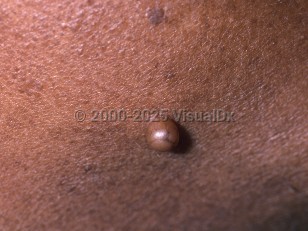Cutaneous neuroma in Adult
Alerts and Notices
Important News & Links
Synopsis

Neuromas are single or multiple benign cutaneous tumors of neural tissue (Schwann cells and axons). There are two major types of cutaneous neuromas: 1) traumatic and 2) palisaded, encapsulated.
Traumatic neuroma (amputation neuroma, pseudoneuroma, scar neuroma) – Traumatic neuroma is a solitary papulonodular tumor at a previous site of trauma, surgery / amputation, or scar. It is thought to form as aberrant nerve regeneration following injury, with subsequent inflammation, fibrosis, scarred tissue formation, and disorganized proliferation of nerve fascicles. This entity has no specific predilection for sex, anatomic site, or age. Some rudimentary supernumerary digits are considered a congenital variant of traumatic neuroma due to in utero amputation of a supernumerary digit.
Palisaded encapsulated neuroma (PEN, solitary circumscribed neuroma) – Palisaded encapsulated neuroma is a solitary, spontaneous papulonodular growth secondary to the proliferation of nerve fibers encapsulated within the perineum (hence its encapsulation). There is no clear etiology. Often PEN favors the face, but it can also appear on the neck, genitalia, trunk, extremities, hands, and feet. It is most common in middle-aged adults. As opposed to traumatic neuroma, there is typically no inciting trauma.
Multiple nonencapsulated PENs are plexiform and intraneural variants of PENs. Multiple mucosal nonencapsulated PENs are pathognomonic findings in multiple endocrine neoplasia type 2B (MEN2B). Multiple nonencapsulated PENs are found on both the mucosal and cutaneous surfaces of the face and distal extremities in PTEN hamartoma tumor syndrome (including Cowden syndrome, Bannayan-Riley-Ruvalcaba syndrome, PTEN-related Proteus syndrome, and Proteus-like syndrome). Lesions typically appear at birth or during early childhood.
Traumatic neuroma (amputation neuroma, pseudoneuroma, scar neuroma) – Traumatic neuroma is a solitary papulonodular tumor at a previous site of trauma, surgery / amputation, or scar. It is thought to form as aberrant nerve regeneration following injury, with subsequent inflammation, fibrosis, scarred tissue formation, and disorganized proliferation of nerve fascicles. This entity has no specific predilection for sex, anatomic site, or age. Some rudimentary supernumerary digits are considered a congenital variant of traumatic neuroma due to in utero amputation of a supernumerary digit.
Palisaded encapsulated neuroma (PEN, solitary circumscribed neuroma) – Palisaded encapsulated neuroma is a solitary, spontaneous papulonodular growth secondary to the proliferation of nerve fibers encapsulated within the perineum (hence its encapsulation). There is no clear etiology. Often PEN favors the face, but it can also appear on the neck, genitalia, trunk, extremities, hands, and feet. It is most common in middle-aged adults. As opposed to traumatic neuroma, there is typically no inciting trauma.
Multiple nonencapsulated PENs are plexiform and intraneural variants of PENs. Multiple mucosal nonencapsulated PENs are pathognomonic findings in multiple endocrine neoplasia type 2B (MEN2B). Multiple nonencapsulated PENs are found on both the mucosal and cutaneous surfaces of the face and distal extremities in PTEN hamartoma tumor syndrome (including Cowden syndrome, Bannayan-Riley-Ruvalcaba syndrome, PTEN-related Proteus syndrome, and Proteus-like syndrome). Lesions typically appear at birth or during early childhood.
Codes
ICD10CM:
D21.9 – Benign neoplasm of connective and other soft tissue, unspecified
SNOMEDCT:
404018006 – Cutaneous neuroma
D21.9 – Benign neoplasm of connective and other soft tissue, unspecified
SNOMEDCT:
404018006 – Cutaneous neuroma
Look For
Subscription Required
Diagnostic Pearls
Subscription Required
Differential Diagnosis & Pitfalls

To perform a comparison, select diagnoses from the classic differential
Subscription Required
Best Tests
Subscription Required
Management Pearls
Subscription Required
Therapy
Subscription Required
References
Subscription Required
Last Updated:09/30/2019
Cutaneous neuroma in Adult

